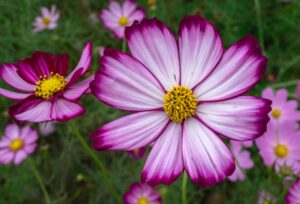Welcome, fellow garden enthusiasts, to the realm of cosmos flowers – the celestial beauties that grace our gardens with their ethereal charm. If you’re looking to add a touch of celestial magic to your outdoor space, then cosmos flowers are the perfect choice.
Let’s begin by unraveling the mystique surrounding cosmos flowers. Originating from the Greek word for “harmony” or “ordered universe,” cosmos flowers belong to the Asteraceae family and are native to Mexico and the southern United States. These dainty yet resilient flowers come in various colors, including shades of pink, white, red, and even chocolate. With their delicate foliage and intricate blooms, cosmos flowers have captured the hearts of gardeners worldwide.

Cosmos flowers are annual plants, meaning they complete their life cycle within a single growing season. They belong to the Asteraceae family, which includes daisies, sunflowers, and asters. The most common variety, Cosmos bipinnatus, features finely divided, fern-like foliage and dainty, daisy-like flowers that bloom atop long, slender stems.
One of the most captivating aspects of cosmos flowers is their wide range of colors, which span from delicate pastels to vibrant shades of pink, magenta, orange, and crimson. Some varieties even boast bi-colored or striped petals, adding an extra dimension of visual interest to the garden.
These versatile blooms can grow anywhere from 1 to 6 feet in height, depending on the variety and growing conditions. They thrive in full sun and well-drained soil, making them ideal candidates for sunny borders, wildflower meadows, and cottage gardens.
Sunlight Requirement of Cosmos Flowers
The key to successful cosmos cultivation lies in selecting the perfect spot for your plants to thrive. Cosmos flowers thrive in full sun, so be sure to choose a location in your garden that receives at least 6-8 hours of direct sunlight per day.

Soil Requirement of Cosmos Flowers
Cosmos prefers well-draining soil with a neutral to slightly acidic pH. If your soil is heavy or clay-like, consider amending it with organic matter, such as compost or peat moss, to improve drainage and fertility.
Temperature and Humidity Requirement
Once established, cosmos thrive in moderate to warm temperatures, with daytime temperatures ranging from 70-85°F (21-29°C). They are relatively tolerant of heat and can withstand summer temperatures, provided they receive adequate moisture. While cosmos are heat-loving plants, they can also tolerate cooler temperatures, especially in the fall when temperatures begin to drop.

Planting Cosmos Seeds
Before you start sowing seeds or planting seedlings, it’s essential to choose the right variety of cosmos flowers for your garden. There are several species and cultivars to choose from, each with its unique characteristics. Whether you prefer the classic Cosmos bipinnatus, the vibrant Cosmos sulphureus, or the elegant Cosmos atrosanguineus (chocolate cosmos), selecting the right variety will ensure a successful and visually appealing garden display.
Now that you’ve selected your preferred cosmos variety, it’s time to get your hands dirty and start planting. Cosmos flowers are relatively easy to grow from seeds, making them an ideal choice for novice and experienced gardeners alike.
Choose a sunny spot in your garden with well-draining soil, and sow the seeds directly into the ground after the last frost date has passed.
Remember to space the seeds or seedlings adequately to allow for proper airflow and growth.
Once the seedlings have established a few sets of true leaves, you can thin them out to prevent overcrowding and promote healthier growth.
Aim for spacing of about 12-18 inches between plants to allow for adequate airflow and sunlight.

Water Requirement of Cosmos Flowers
Once your cosmos plants are established, they’ll require minimal maintenance to keep them looking their best. Water them regularly during dry spells, but be careful not to overwater, as the cosmos are drought-tolerant once established.
Fertilizer Requirement
Applying a balanced fertilizer once a month during the growing season will help promote lush foliage and abundant blooms.
Deadheading Cosmos Flowers
To encourage continuous blooming and maintain the appearance of your cosmos plants, regular pruning and deadheading are essential. Deadheading involves removing spent flowers before they can go to seed, redirecting the plant’s energy into producing more blooms. Additionally, pruning can help shape the plants and prevent them from becoming overly leggy. Remember to sterilize your pruning tools to prevent the spread of disease between plants.

Dealing with Pests and Diseases
While cosmos flowers are relatively resistant to pests and diseases, they may occasionally encounter some common garden nuisances. Aphids, spider mites, and whiteflies are among the pests that may target cosmos plants, sucking sap from the leaves and causing damage. Fortunately, many natural and organic pest control methods, such as insecticidal soaps and neem oil, can help keep these pests at bay. Regularly inspecting your plants for signs of infestation and addressing any issues promptly will help ensure their health and vitality.
Saving Seeds and Overwintering
As the gardening season draws to a close, you may want to save seeds from your cosmos flowers to replant next year. Allow the seed heads to fully mature and dry on the plant before harvesting them. Once harvested, store the seeds in a cool, dry place until you’re ready to sow them again in the spring. If you live in a region with cold winters, you may also need to take steps to overwinter your cosmos plants, such as mulching or bringing potted plants indoors.
Types and Cultivars of Cosmos Flowers
Cosmos Bipinnatus
This is the most common species of cosmos and the one typically found in gardens. Known for its feathery foliage and daisy-like flowers, Cosmos bipinnatus blooms in a spectrum of colors, including white, pink, and deep crimson. It’s a favorite among pollinators and adds a whimsical touch to any garden bed or bouquet.

Cosmos Sulphureus
Unlike its bipinnatus counterpart, Cosmos sulphureus boasts a more compact growth habit and vividly colored blooms. Its flowers range from golden yellow to fiery orange, adding a burst of warmth and radiance to any garden landscape. This species is particularly well-suited to hot and sunny climates.

Chocolate Cosmos (Cosmos atrosanguineus)
Aptly named for its rich, chocolatey fragrance and deep burgundy hue, this species is a true sensory delight. While its flowers may be smaller compared to other cosmos varieties, their intense color and captivating scent more than make up for it. Chocolate cosmos are beloved by gardeners seeking to indulge their senses.

Cosmos Bipinnatus ‘Sea Shells’
As the name suggests, the ‘Sea Shells’ cultivar of Cosmos bipinnatus features uniquely shaped petals that resemble the delicate curves of seashells. This cultivar adds a touch of whimsy and intrigue to garden beds and floral arrangements, with flowers ranging from soft pastels to vibrant pinks and purples.
Cosmos Bipinnatus ‘Sensation’
With larger flowers and sturdy stems, the ‘Sensation’ cultivar of Cosmos bipinnatus is a favorite among gardeners looking to make a bold statement. Available in a wide range of colors, including white, pink, and crimson, ‘Sensation’ cosmos are perfect for adding vertical interest and visual impact to any garden setting.

In conclusion, cosmos flowers are a delightful addition to any garden, offering beauty, versatility, and ease of cultivation. By following the tips and techniques outlined in this guide, you can enjoy a bountiful display of cosmos blooms year after year. So, why not embark on your cosmic gardening adventure and let your garden bloom with celestial splendor? Happy gardening!


